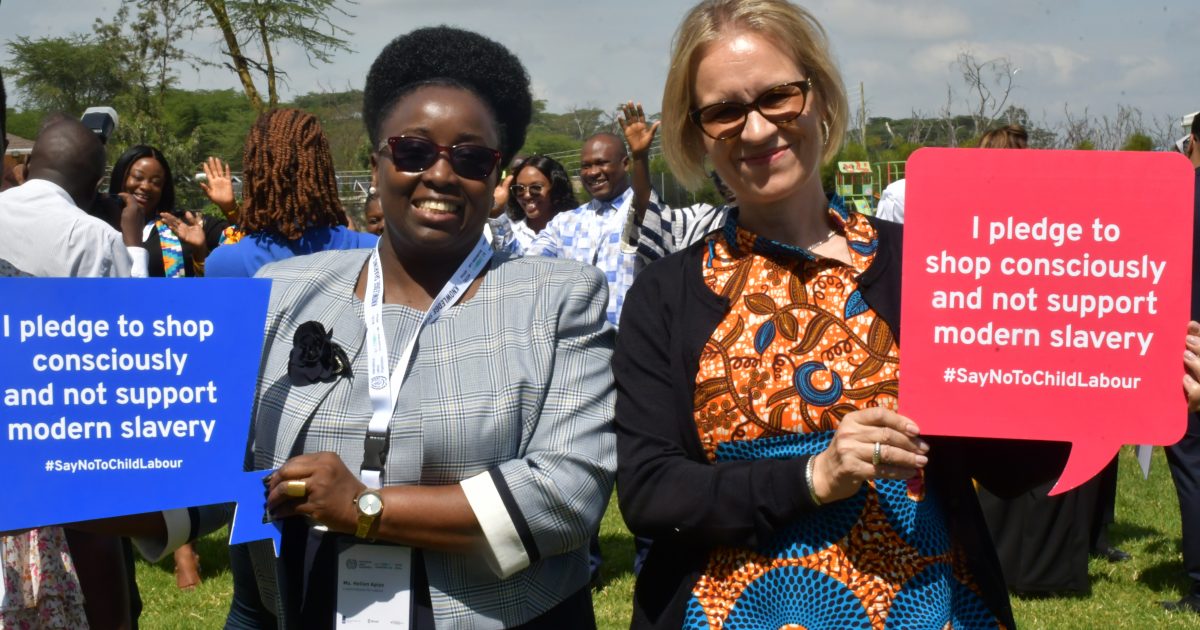The State Department for Labour and Skills Development Principal Secretary Shadrack Mwangolo Mwadime has called for collaborative efforts in order to reduce rising cases of forced labour and child labour in Africa.
Mwadime said millions of children around the world, particularly in Africa, are deprived of their childhood, education, and future prospects due to their engagement in work that compromises their ability to grow and develop to maturity.
Subsequently, he urged all stakeholders to unite in their efforts in implementing innovative solutions, drawn from best practices, and align initiatives with the African Union’s Ten-Year Action Plan that aims to eradicate child labour by 2025 and forced labour, human trafficking, and modern slavery by 2030.
The remarks were contained in a speech read on his behalf by the Labour Commissioner at Ministry of Labour and Social Protection Ms. Hellen Apiyo during a knowledge sharing forum on innovative solutions to reduce Child Labour and Forced Labour in Africa.
The forum held in Naivasha on Tuesday brought together 11 African Countries including; Angola, Kenya, South Sudan, Zambia, Madagascar, and Sierra Leon among others.
“To effectively reduce child labour, it is crucial to adopt a holistic and integrated approach that combines education, community engagement, economic empowerment, legal enforcement, and technological innovation. By addressing the underlying causes of child labour and providing sustainable alternatives, we can create a future where all children can enjoy their childhood and have the opportunity to pursue their education and dreams,” the PS stated.
He revealed that globally, an estimated 160 million children are engaged in child labour, with Africa bearing the highest burden. According to Mwadime, the factors contributing to child labour are multifaceted, including poverty, lack of access to quality education, and weak enforcement of labour laws, adding that addressing these challenges requires comprehensive and innovative approaches.
The PS noted that through collaboration with other countries, Kenya can benchmark best practices and enhance its efforts to combat child labour. This collaboration can take various forms, including bilateral agreements, participation in international conferences, expert exchanges, and joint research. Through these initiatives, he said Kenya can learn from the successes and challenges of other nations, adapt effective strategies to its context, and ultimately create a safer and more equitable environment for its children.
Mwadime reiterated that Kenya will continue to ensure that we develop sound policies and programs, enforcement of law through child labour inspections and audits in line with the various statutes, advocacy and awareness campaigns to ensure compliance with child labour laws and added that the Ministry has also developed a National Policy on the Elimination of Child Labour which outlines the government’s commitment and strategic approach to eradicating child labour.
International Labour Organisation (ILO) Assistant Director General Mia Seppo on her part revealed that according to the 2020 Global Estimates, child labour surged from 152 million in 2016 to 160 million in 2020, with 92 million in Africa alone, which is a staggering increase of 20 million over the past four years alone. This means that one out of every five African children are now trapped in child labour.
She stated that over 80 per cent of this child labour occurs in agriculture, noting that these figures do not account for the COVID-19 pandemic’s impact which increased inequality between countries and within countries.
Ms Seppo shocked the audience when she revealed that the 2021 Global Estimates of Modern Slavery report shows 27.6 million people are in forced labour globally, with 3.8 million being in Africa and women and girls making up 11.8 million of this global figure, including 3.3 million children.
The ILO Assistant Director General said the meeting in Naivasha brought together the aforementioned African countries to take stock of achievements made in stemming child and force labour and come up with country and regional specific framework to end forced and child labour.

“For three decades, the ILO has led global efforts against child labour, focusing on rural and informal economies, global supply chains, and crisis situations. Our commitment is to eradicate child and forced labour while upholding fundamental rights at work, including of ILO Convention 138 and 182 which Kenya ratified in 1979,” noted Ms Seppo.
Kenya as a Member of the International Labour Organisation (ILO), is obligated to fulfill all the requirements of not only Convention Number 182 on Elimination of Worst Forms of Child Labour but also Convention Number 138 on Minimum Age of admission into employment.
The African Union Commission developed a Proposal titled “Enhancing the protection of Children in Vulnerable Populations,” focusing on combating child labour and establishing a programmatic response to children on the move in Africa which is grounded in Agenda 2063 and its First Ten-Year Implementation Plan, as well as Agenda 2040. This initiative also aligns with the African Union Ten Year Action Plan on Eradication of Child Labour, Forced Labour, Human Trafficking, and Modern Slavery in Africa (2020-2030), targeting SDG goal 8.7.
Seppo said this plan is also closely aligned with the Durban Call to Action, emphasizing integrated efforts among governments, international organisations, civil society, and businesses to achieve SDG target 8.7. All these initiatives, she said aim to strengthen legal frameworks, social protection mechanisms, and coordination efforts at national, regional, and continental levels to enhance the rights and well-being of children in Africa.
By Mabel Keya Shikuku





